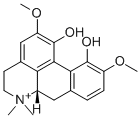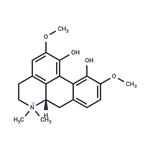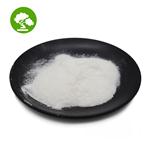A wide variety of species contain this quaternary alkaloid which is widespread
among the families, Aquilegia, Magnolia and Michelia. It has been isolated and
characterized as the iodide, m.p. 248-9°C (dec.); [0:11>5 + 200.1° (MeOH). The
optically inactive base also yields an iodide which crystallizes with 1.5 H20,
m.p. 243°C (dec.).
Magnoflorine is an alkaloid and a major constituent of S. acutum that has diverse biological activities. It reduces hemolysis induced by lysophosphatidylcholine (LPC), but not NaCl, in a rat erythrocyte suspension when used at concentrations ranging from 0.01 to 10 μM. Magnoflorine (10 μM) induces intracellular chloride influx in neuroblastoma cells, an effect that is reversed by the GABAA receptor antagonist bicuculline . It reduces TNF-α-induced NF-κB expression as well as production of IL-6 and IL-8 in BEAS-2B cells. In vivo, magnoflorine (20 mg/kg, i.p.) improves short- and long-term memory acquisition in a passive avoidance test in a mouse model of scopolamine-induced memory impairment.
Magnoflorine-d3 is the labelled analogue of Magnoflorine, an isoquinoline alkaloid from the Coptis japonica and it enhances the myoblast differentiation through activation of the p38 MAP kinase and Akt pathway.
Nakano., Chem. Pharm. Bull. (Tokyo), 2, 329 (1954)
Tomita, Kikkawa.,J. Pharm. Soc., Japan, 77, 195 (1957)
Gopinath et aI., J. Sci. Ind. Res., 18B, 444 (1959)
Ishii, Harada.,J. Pharm. Soc., Japan, 81,238 (1961)
Yang, Lu, Hsiao., ibid, 82,794,816 (1962)
Yang, Lu, Hsiao., ibid, 83,216 (1963)



